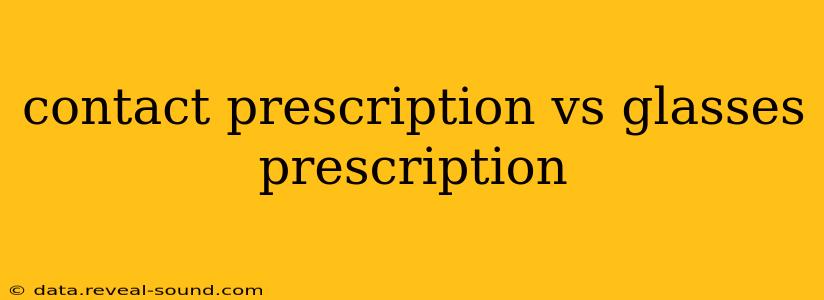Choosing between contact lenses and glasses often comes down to personal preference, lifestyle, and vision needs. However, a crucial factor many overlook is the difference between the prescriptions themselves. While both correct your vision, contact lens and glasses prescriptions aren't interchangeable. This article will clarify the key distinctions and why it's essential to have separate prescriptions for each.
What's the Difference Between a Contact Lens and Glasses Prescription?
The core difference lies in how the corrective lens interacts with your eye. Glasses sit a distance away from your cornea (the front surface of your eye), while contact lenses rest directly on it. This distance significantly impacts the refractive power needed to achieve clear vision. A glasses prescription compensates for this distance, resulting in a different power than what's needed for a contact lens.
Why Can't I Just Use My Glasses Prescription for Contacts?
Using your glasses prescription for contact lenses can lead to several issues, including:
- Blurred vision: The most common problem. Incorrect power can cause significant discomfort and blurry vision.
- Eye strain: Constant focusing effort to compensate for the incorrect correction can lead to headaches and eye strain.
- Discomfort: The wrong prescription might cause your eyes to feel dry, itchy, or irritated.
- Increased risk of eye infections: Improper fitting and prescription can compromise the health of your eyes, increasing the risk of infections.
What About the "P" Values in My Prescription?
This refers to the Pupillary Distance (PD). Your PD measures the distance between the centers of your pupils. This measurement is crucial for glasses but less critical for contact lenses. Glasses rely on accurate PD for proper alignment of the lenses with your eyes. Incorrect PD can lead to double vision or eye strain. Contact lenses, being directly on the eyes, don't have the same PD considerations.
How Often Should I Get New Contact Lens and Glasses Prescriptions?
Regular eye exams are essential for both glasses and contacts. Your eye doctor will determine the frequency based on your individual needs, but typically, you'll need:
- Glasses prescription: Renewed every 1-2 years, or as recommended by your ophthalmologist.
- Contact lens prescription: Requires more frequent updates, typically annually, or even more often if there are changes in your vision or eye health.
Can I get a contact lens prescription online?
While online vision tests exist, they are not a substitute for a comprehensive eye exam performed by a qualified eye care professional. A thorough exam checks for eye health issues and ensures the correct prescription and fitting for contact lenses.
What measurements are included in a contact lens prescription but not a glasses prescription?
A contact lens prescription will include specific measurements related to the lens itself, such as:
- Lens diameter: The overall size of the contact lens.
- Base curve: The curvature of the contact lens, matching the curvature of your cornea.
- Lens material: Specifies the type of contact lens material used (e.g., silicone hydrogel).
- Lens power (spherical, cylindrical, and axis): Similar to glasses but tailored to the contact lens's placement on the eye.
What Should I Do If I Need Both Glasses and Contacts?
Getting separate prescriptions for both is vital. Never attempt to use one prescription for both. Schedule comprehensive eye exams with your eye doctor to obtain the correct prescriptions for both glasses and contact lenses. They can discuss the best options for your individual needs and lifestyle. They will assess your overall eye health and provide you with the safest and most effective vision correction.
Remember, your eye health is paramount. Always consult a qualified ophthalmologist or optometrist for any questions or concerns regarding your vision. They can provide personalized advice and ensure you receive the appropriate care.
